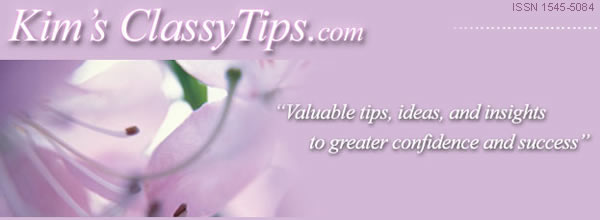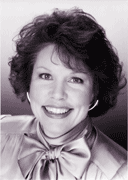

![]() Welcome to my ClassyTip for this week which focuses on:
Welcome to my ClassyTip for this week which focuses on:
- Appearance
- Behavior
- Communication
- Answering Your Questions about Stationery- Tip #13
Last week my ClassyTip covered handwritten notes, and I received a number of questions regarding what sizes and type of stationery should be used. So this week I’ll give you the basics for building your stationery collection.
Before we look at color and sizes, let’s review paper construction. As I mentioned in the last ClassyTip #12, Crane’s 100% cotton fiber is a standard to use for quality. This paper has texture and weight that makes it a pleasure to write on and to handle. There’s an understated elegance and importance given to notes written on good quality paper.
Wood pulp fiber is used to manufacture most paper, and even Crane now uses it to make some of its stationery products. If you’re not sure about a piece of Crane, hold it up to the light and look for the watermark. If it’s 100% cotton you’ll see a translucent image that states this fact.
There are many beautiful papers used for stationery, and your selection will be based upon your taste, the occasion for using the stationery, and your budget.
Formal and business correspondence will require subdued colors in good quality paper. Informal and casual correspondence may run the gamut from simple and elegant to fun and colorful paper.
Having your name engraved on your stationery is certainly a nice touch, but by no means is it necessary. It’s far better to write your thoughts to someone on plain stationery, than to have a box of engraved correspondence cards that are never used.
If
you have a little time, browse through the excellent resources and
information at the Crane Stationery Website - just press on this link ![]()
Correspondence Cards - One of the most useful sizes for a man or woman to write a short hand written note in both social and business circumstances. They’re approximately 6¼ ”X 4¼ ” and made from card stock weight paper. Your name can be engraved at the top center. This card is never folded, and you’ll only write on the front. One or two words scrolled across the card can look just as appropriate as a multi-lined message.
At times you’ll need to write a longer note or a letter. In these cases the following stationery overview will help you with your paper selection. The sizes listed are approximate, and “print’ refers to using a computer or word processor.
Business correspondence - Paper selection is the same whether you’re a man or woman.
-- Company Letterhead
(8½ X 11”)
All correspondence is typed or printed on this stationery.
-- Executive Stationery
- Monarch Sheets (7½ X 10½”)
- Your name can be engraved at the top center.
- Hand-Write or print only on the front page.
This size is used for personal business letters, and is distinctive because
it’s slightly smaller than the company letterhead.
Social
Correspondence - Men
-- Monarch Sheets (7¼ X 10½”)
- Plain paper, with no borders.
- Your name can be engraved at the top center.
- Hand-write or print only on the front.
- The paper is folded in thirds to put into an envelope.
If you’re printing a personal letter, it’s nice to use a
font not generally used for business.
Social Correspondence
- Women
Historically, women in a family handle the social correspondence so there
are more choices available for a woman than for a man.
-- Informals (5 X
4”)
- Pre-folded with the fold at the top.
This folded note card, with or without engraving, is very useful and
should always be kept on hand. You may decide to have a collection of
these, ones to fit a fun, spontaneous note and others for a more sedate
or elegant occasion.
- Name engraved – center
front.
Write on page three, never on the back page.
- Monogram engraved – center, top center or top left.
Write on page three if monogram is centered on front.
Can write on front page if monogram is top center or left.
-- Correspondence
Sheets, Half Sheets (6¼ X 8½”)
- Single sheets, either plain or may have a border.
- Write only on the front of the sheet, within the border.
- The sheet is folded in half to slip into its envelope.
- Your name and address, or just address, may be engraved top center.
With only an engraved address, others in the family or guests can use
the paper as house stationery.
-- Letter Sheets – Very formal (5¼ X 7¼”)
- Pre-folded with the fold at left edge.
- Write on pages 1, 3, then 2, in that order, never on 4.
The finished letter is folded top down, then placed into its envelope
with the fold at the bottom of the envelope.
Your correspondence is a direct reflection of you. The classy person wants the recipient of his or her note to feel special when reading it. The correct stationery selection will reinforce your written message.
If
you have a little time, browse through the excellent resources and
information at the Crane Stationery Website - just press on this link ![]()
I'm Looking forward to sending you another of my ClassyTips next Wednesday. Until then, have a great week, and don't forget to visit my Forum that answers your questions on 'Becoming the Best You Can Be'.

Do you have a friend or associate you think may like to receive my free, weekly ClassyTips Newsletter? If so, just press here to let them know.
Also, remember you can always send your questions, thoughts, ideas, and suggestions directly to me at Kim's ClassyTips
For help, please email support@ClassyTips.com
© 2003 ClassyTips.com - all rights reserved
secure-mailer.net
is powered by
AutoResponse
Plus